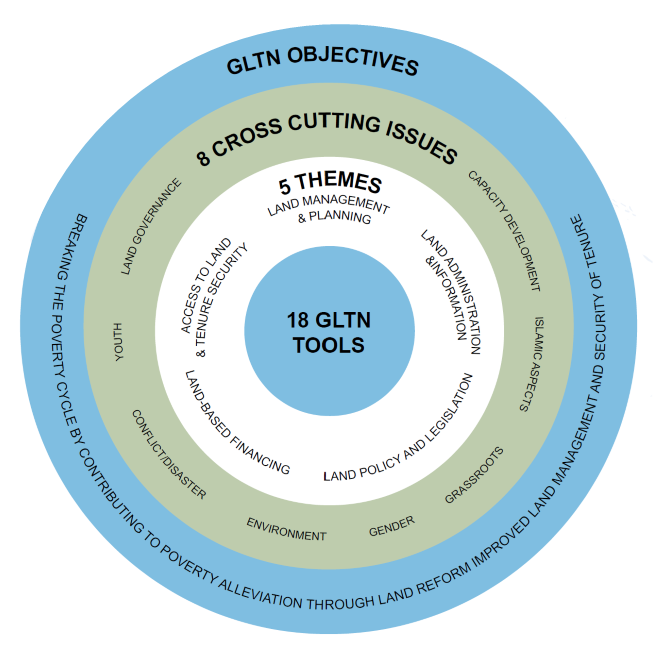
Theme 4: Land Management and Planning
Introduction to Land Management and Planning Tool 10: Citywide slum upgrading Tool 11: Citywide spatial planning Tool 12: Regional land use planning Tool 13: Land readjustment (slum upgrading and/or post crisis)
 Introduction to Land Management and Planning
Introduction to Land Management and Planning
The objective of land use planning is to ensure that land and its resources are used efficiently for the benefit of the wider economy and population, while protecting the environment. Land information is an essential tool for land use and spatial planning. It can be acquired through conventional land information systems. Land information systems may have various forms and varying levels of accuracy, depending on the purpose for which they were created: planning (delineation of properties and existing land use); legal (determination of legal ownership, registrations of transactions); taxation (determination of the assessed value of the land). Land information is usually provided by cadastres. They usually combine these three objectives (multipurpose cadastres) or only two of them. Cadastres must be descriptive, exhaustive and permanently updated. An updated cadastral system is usually required for the systematic registration of land titles.
In the case of informal settlements and customary areas land information can be acquired through participatory planning processes. The community being upgraded is a key element in the supply of information.
The discussion will focus on land information tools and land-use planning in relation to informal settlement upgrading and regularisation as well as for sustainable agriculture and food security.
Tool 10: Citywide slum upgrading
Responses to the housing needs of the urban poor need to be twofold: the provision of serviced sites, and in situ upgrading of existing informal settlements. There are two main forms of intervention: physical upgrading (provision or improvement of infrastructure and basic services'85) and tenure upgrading or regularisation. Physical and tenure upgrading must be carried out in parallel.
Scaling up remains the major challenge that informal settlement upgrading and regularisation policies are confronted with.
In thesence of citywide slum upgrading strategies, and without appropriate legal framework and procedures or human and financial resources, informal settlements regularization is usually planned on an ad hoc, settlement-by-settlement basis, with the accompanying risk of increasing market pressure on upgraded slums, and accelerating gentrification.
Lessons from recent experiences confirm the relevance of citywide approaches. Instead of focusing on individual settlements or on the city limits as the area for planning, the focus should be on
- improving primary infrastructure networks, and
- adopting and enforcing tenure regularisation procedures at city, regional, or national levels.
Current experience in Thailand ("Baan Mankong" programme) underlines the key role of citywide programmes in which urban poor organizations are fully involved, the importance of horizontal linkages between these organisations, and of savings and credit mechanisms.
Another approach to citywide slum upgrading is that seen in Brazil, where the national urban land regularisation programme combines community participation at settlement and city level with government intervention backed by a set of legal measures adopted at national level, and new urban management concepts ("the City Statute").
Questions for tool developers
- What are the main obstacles to defining and enforcing citywide slum upgrading?
- What are the alternatives to in situ upgrading?
- What are the prerequisites for implementing at city and local levels slum upgrading strategies adopted at national level?
- What are the most appropriate infrastructure provision options compatible with citywide incremental slum upgrading strategies?
Citywide slum upgrading: Related Publications
- Informal Urban Development in Europe Experiences from Albania and Greece Summary (Eng - 2010)
- Citywide Strategic Planning: A Guideline (Eng - 2010)
- Improving data collection for urban planning through participatory enumerations - Brief 2 (Eng - 2010)
- A situational analysis of metropolitan Port-au-Prince, Haiti Strategic citywide spatial planning Full Report (Eng - 2009)
- Land, Environment and Climate Change: Challenges, Responses and Tools (Eng - 2010)
Tool 11: Citywide spatial planning
Spatial planning brings together and integrates policies for the development and use of land with other policies and programmes. It refers to the methods used by the public sector to influence the distribution of people and activities in spaces of various scales. It goes beyond traditional land use planning, which focuses on the process of organizing the use of land and its resources to meet people's needs over time. However, in many countries, elitist urban planning practices and exclusionary legal regimes have not beenle to provide appropriate responses to the upgrading and regularisation of informal settlements. Nevertheless, the question of land regularisation should be considered as one of the central axes in formulating citywide plans.
Conventional city planning endash as illustrated by Master Plans endash is rarely adapted to the situation that prevails in most cities. It is a centralised top-down process, the collection and processing of information is time-consuming and costly, it has difficulty in taking into account the de facto situation on the ground, especially when informal settlements are considered as illegal, and a lack of human resources makes it difficult to implement the plan at local level. If people on the ground do not adhere to the plan, it is not sustainable.
Citywide planning can be an alternative to the settlement-by-settlement approach and conventional planning. It aims to reach the entire population, to make provision for the future growth of low-income settlements, especially basic rights of way for primary infrastructure, to provide flexibility and adaptability to planning documents. A Master Plan can be used as a starting point or for strategic guidelines, but emphasis is put on participatory planning processes, which involve all stakeholders, and especially the community: provision of information on the informal settlements before planning; identification of needs and of slum upgrading priorities; major infrastructure proposals; zoning alterations; changes in planning norms; cost recovery.
Questions for tool developers
- How can decision-related servicing and land use be linked with security of tenure issues in spatial planning?
- Which conditions must be met?
- How, and under which conditions, can existing conventional planning tools endash such as Master Plans endash be integrated and adapted to the needs of innovative citywide planning processes involving all stakeholders?
- What changes are required in the legal and regulatory framework, especially for ensuring adequate cooperation between central and local institutions?
- Does the implementation of citywide spatial planning require a specialised agency, or can it rely on existing institutions?
Tool 12: Regional land use planning
Regional planning is a branch of land use planning and deals with the efficient placement of land use activities, infrastructure and settlement growth across a significantly larger area of land than an individual city or town.
Regions require various land uses; protection of farmland, cities, industrial space, transportation hubs and infrastructure, military bases, and wilderness. Regional planning is the science of efficient placement of infrastructure and zoning for the sustainable growth of a region. Advocates for regional planning promote the approach because it can address region-wide environmental, social, and economic issues which may necessarily require a regional focus.
A 'region' in planning terms can be administrative or at least partially functional, and is likely to include a network of settlements and character areas.
For decades, except in metropolitan areas, and in the developed countries in particular, land use planning was mainly limited to densely urbanised or municipal areas. Planning decisions involving urban regions or neighbouring local authorities were usually placed under the responsibility of ad-hoc commissions. In many cities, the implementation of Master Plans has been repeatedly compromised by changes in municipal boundaries.
Conflicting interests, and a lack of appropriate financial mechanisms for the construction and maintenance of infrastructure of regional interest have frequently resulted in major problems, especially regarding transport, water and sanitation. Furthermore, poor land use control endash if any endash in areas outside municipal jurisdictions have attracted both informal developers and low-income communities excluded from access to land in municipal areas. This phenomenon has been aggravated by land speculation.
With an accelerated rate of urbanisation, urban sprawl and the extension of built-up areas far beyond municipal boundaries, and the expansion of informal settlements it is no longer possible to limit planning interventions to municipal areas.
Also, with increased occupancy rates in rural areas, an increase in off farm production and intensive farming methods, land use planning becomes critical for sustainable land management. It is also critical for the delivery of agricultural inputs through the supply of road networks, electricity, and railways, as well as for moving goods to markets in country and for export. Land use planning is also closely tied with the preservation of the environment, such as sensitive wetlands, coastal zone areas etc.
Questions for tool developers
- What kind of statutory body, or institution, can be made responsible for
- defining regional land use planning orientations, and
- enforcing planning regulations?
- What are the main problems raised by the regularisation of informal settlements located in peri-urban areas not covered by land use planning regulations?
- Can regional land use planning
- limit the impact of the land market on land prices at regional level, and
- provide land for resettlements resulting from tenure regularisation programmes?
- How can land use planning be linked to improved environmental management?
- How can land use planning be linked to improved food security and agricultural production?
Tool 13: Land readjustment (slum upgrading and/or post crisis)
Land readjustment is an approach whereby land-ownership and land use of fragmented adjoining sites is re-arranged, usually in order to provide land for development purposes: slum upgrading and regularisation; orderly development of new residential areas; planned development of vacant areas that are expected to turn into residential areas.
Land readjustment projects are divided into two phases:
- readjustment options are considered and discussed with the owners and occupants;
- plots are reallocated. In urban areas especially, reallocation is based on the value rather than the size of the land.
Land pooling is a form of land readjustment whereby the whole process is under the responsibility of a public agency, with all rights holders in a compulsory partnership.
In post-conflict or -crisis situations, land readjustment or land pooling may be an effective tool for responding to population distribution changes. It can be adapted to the re-blocking and regularisation of customary land developments (Benin).
Another form of land readjustment is land sharing. This is of particular interest for informal settlement upgrading and regularisation. The owner of land occupied by an informal settlement is given incentives to lease or sell part of his property to the occupants, below market price, and to recover and develop the remaining part of the land.
So far, land readjustment and land pooling as implemented in Taiwan, Japan or Korea have not really benefited low-income occupants, whose tenure status is fragile, and drastic increases in land prices following land readjustment have generally accelerated gentrification in the areas concerned.
Land sharing, as implemented in Thailand, India, or Indonesia, requires strong community organisation and the coordinated intervention of several stakeholders: community, land owner, credit institution, land development agencies, government land administration institutions.
Questions for tool developers
- What are the institutional prerequisites for land readjustment to work?
- What is the effective cost of land sharing, and what form of financial support does it require?
- What are the conditions for scaling up land sharing projects?
- How can the formal private sector be involved in land sharing processes?
- What are the key blockages to pro poor land readjustment?


